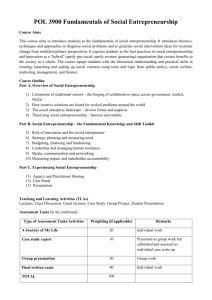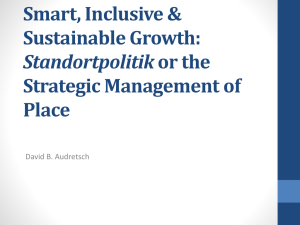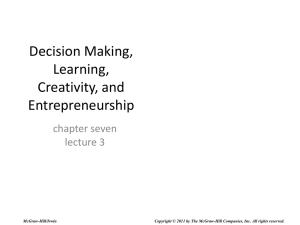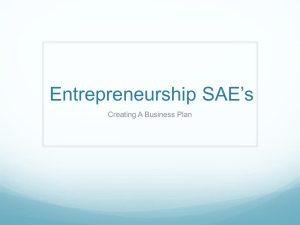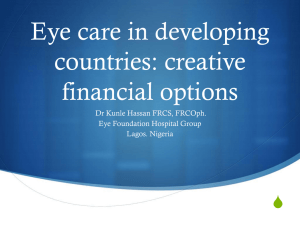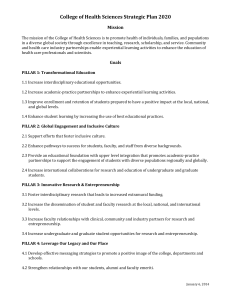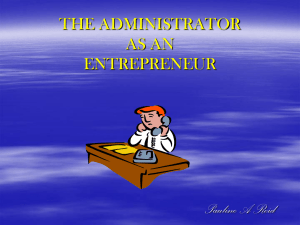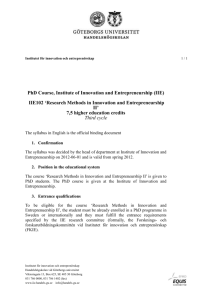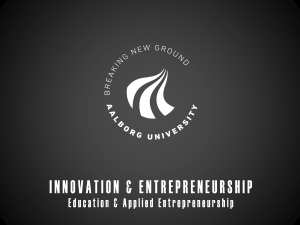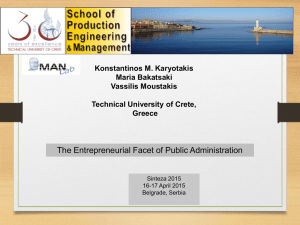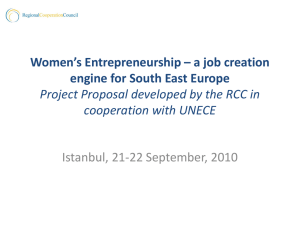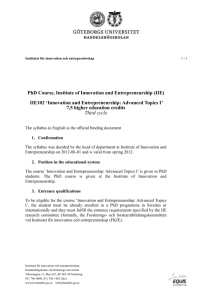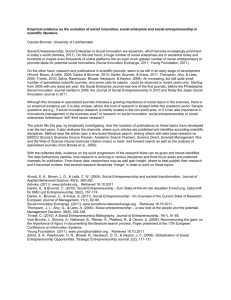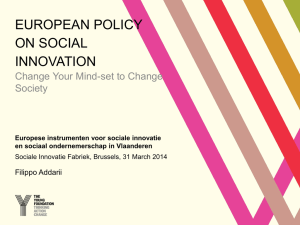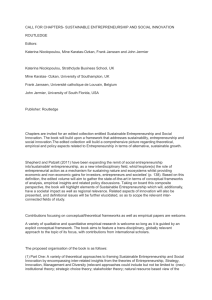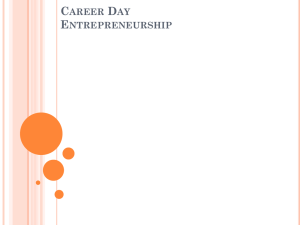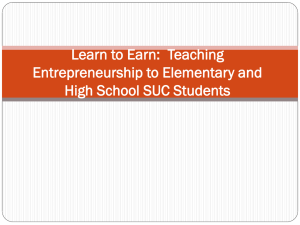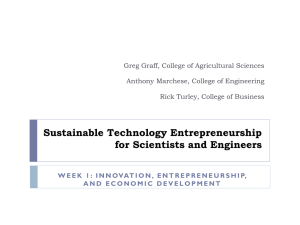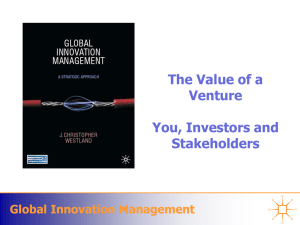EE, LV, FI
advertisement
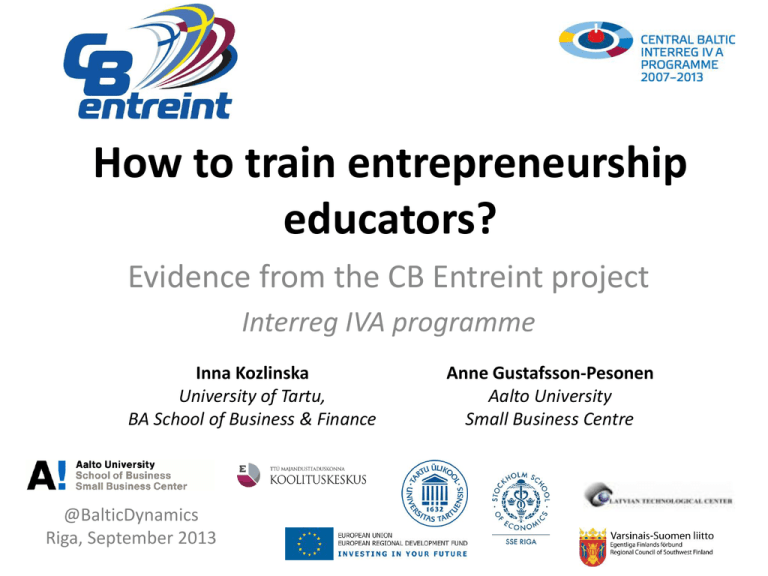
How to train entrepreneurship educators? Evidence from the CB Entreint project Interreg IVA programme Inna Kozlinska University of Tartu, BA School of Business & Finance @BalticDynamics Riga, September 2013 Anne Gustafsson-Pesonen Aalto University Small Business Centre Background of the study (I) • • • • Qualitative research: brainstorming, 34 in-depth interviews Countries: Estonia-11, Latvia-16 and Finland-7 Interviewees: entrepreneurship educators + from the leading HEIs Levels: vocational, higher and continuing education. Aim: to analyse and compare practices and needs, to inform the training programme development Topicality: - findings from earlier studies (EC, 2010; EC, 2008; OECD, 2008; Curavic, 2011); - “The Budapest Agenda: Enabling Teachers for EE” (2011); - how much do we know who the educator is and how e-ship is taught? (Fayolle, 2013). Background of the study (II) Framework: adapted from Béchard & Grégoire’s (2005) Teaching Models in EE: supply, demand, and competence; 6 dimensions – methodology, curricula, evaluation, environment, regulations and financing. Tool: NVivo 10. Descriptive • Varying definitions of the notion: business Vs. attitude and behaviour • Terminology: entrepreneurship Vs. enterprise management/business management • Experience in e-ship: 2-20+ yy, tends to exceed teaching years for younger respondents. Results (I) Methodology, Evaluation – internal • Methods: more practice-based, but more experiential methods are used less, understanding and depth of using them varies a lot. - Rare: creativity development, student lectures, product development, self-reflection (diaries), coaching and workshops by practitioners, practical application of academic projects… • University-industry cooperation: exists, but the most common forms are internships and work placements (real-life projects, innovation teams??). Teaching aims and outcomes: do not always match. EE outcomes measurement: only feedback and tracking alumni. • • Results (II) Curricula – internal: • Integration: yes, in most of the cases. • Interdisciplinarity: truly lacking, currently exists only as part of extracurricular activities (labs, incubators, business competitions). • Specialised EE trainings for educators: practically non-existent. Environment, Regulations, Financing – external: • Physical: inconvenience of study rooms for interactive group work; specialised learning soft not a common tool. • Social: decreasing level of the secondary school preparation (LV); students read less, do not have enough time to prepare. • HEIs management: generally supportive towards EE, but tends to be uninvolving, when actions required (LV, EE). • Insufficient financing of educational initiatives, absence of legislative support in LV as compared to EE & FI. Results (III) Dimension/Model Supply Supply-Demand Demand Demand-Competence Methodology Curricula - - EE, LV, FI EE, LV, FI (EE, LV, FI ) - Evaluation - - EE, LV, FI (EE, LV FI) Environment - EE, LV FI - Regulations - LV EE FI LV, EE - - FI Financing Recommendations for the training programme development (I) I. - Entrepreneurship evolving conceptual views from the economic and social science to the management era and a field on its own (Landström, 2013) - change of the learning paradigms from behaviourism to constructivism – influence on teaching (Kyrö, 2008) practical theory: the process perspective, opportunity recognition, innovation and creativity, product development. Recommendations for the training programme development (II) II. - Entrepreneurship pedagogy and didactics how to set/align objectives, methods, outcomes and measure them teaching models/approaches and the toolbox integration experiential methods inside and outside classroom, e.g.: pedagogical drama, creativity exercises, business games real-life projects with companies, innovation teams, work-based projects, student companies - university-industry networks formation and moderation facilitation. of interdisciplinary teams, The training programme example (6 ECTS, Finland) • The main idea is a blended learning • Need for understanding customer and human-oriented process, in which creative skills are identified and controlled with supportive, listening and goal-oriented way • The idea of the programme is to give the participant: – capabilities to act as an entrepreneurship trainer and developer, as well as a business counselor or in a similar position in a renewable economic environment • Pedagogical framework for the studies is: – Effectuation (Sarasvathy, S.D. 2001) – Ritual pedagogy (Hägg, O. 2011) – Individual differences in affective and conative functions (Snow, R.E., Corno, L. & Jackson, D.N. 1996) – Building conative constructs into entrepreneurship education (Ruohotie, P. & Koiranen, M. 1999) – Cognitive, conative and affective constructs and metaconstructs of personality and intelligence in entrepreneurial learning (Kyrö & al. 2008). What has happened during the studies? • • • • • • • • “I have learnt deeper insights of entrepreneurship as the wide concept, not only to start up business” . “I have learnt experiential learning, dialogues and business canvas”. “I'll be focusing on learning on entrepreneurship, primarily in the training of people through the building on their strengths, and approaching them to do things together, and a practical case in the business world on the basis of reality.” “I’ll do things more hands-on, not theory based.” “I’ll will pay more attention to a personality, how to help people manage themselves and become an entrepreneur.” “I have not been coaching and teaching before. From now on I can use all that I have learned in my work” (business coach). “I have learnt the transformation process from employee to entrepreneur.” “I have learnt to use team methods for supporting entrepreneurial mindset.” THANK YOU! Qs & As…


